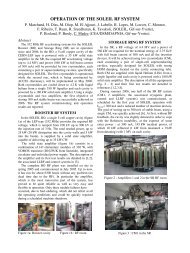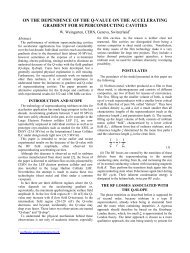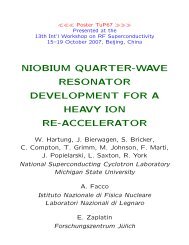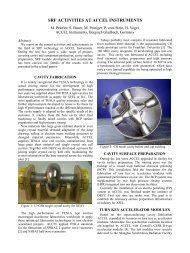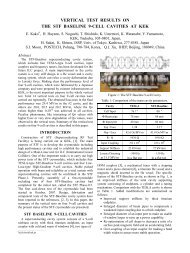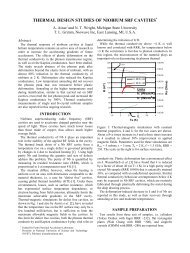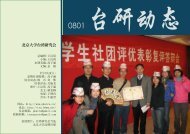study on the buffered electropolishing jacquet layers on niobium cavity
study on the buffered electropolishing jacquet layers on niobium cavity
study on the buffered electropolishing jacquet layers on niobium cavity
Create successful ePaper yourself
Turn your PDF publications into a flip-book with our unique Google optimized e-Paper software.
STUDY ON THE BUFFERED ELECTROPOLISHING JACQUET LAYERS<br />
ON NIOBIUM CAVITY<br />
Erd<strong>on</strong>g Wang, Tianmu Xin, Xiangyang Lu # , Liming Yang, Lin Lin, S<strong>on</strong>g Jin, Kui Zhao<br />
Peking University, Beijing 100871, China<br />
Abstract<br />
Buffered <strong>electropolishing</strong> <strong>on</strong> <strong>niobium</strong> cavities has been<br />
developed at Peking University. Some small <strong>niobium</strong><br />
samples have been polished very smoothly. An<br />
experiment has dem<strong>on</strong>strated that both of <strong>the</strong> liquid and<br />
solid Jacquet <strong>layers</strong> exist <strong>on</strong> <strong>the</strong> surface of anode<br />
simultaneously. The results of experiment, that more than<br />
70% voltage is taken by <strong>the</strong> Jacquet <strong>layers</strong>, show us that<br />
<strong>the</strong> cathode shape is not a necessary c<strong>on</strong>diti<strong>on</strong> for<br />
polishing <strong>the</strong> dumbbell. Flat cathode is available to polish<br />
<strong>the</strong> dumbbell. We have observed though <strong>the</strong> experiment<br />
that <strong>the</strong> different fluid liquid Jacquet layer movements<br />
could cause <strong>the</strong> different results <strong>on</strong> <strong>the</strong> dumbbell surface.<br />
These studies show that BEP can offer a smooth surface<br />
<strong>on</strong> <strong>niobium</strong> cavities.<br />
INTRODUCE<br />
The PKU-ERL-FEL will be based <strong>on</strong> superc<strong>on</strong>ducting<br />
1.3 GHz nine-cell cavities of TESLA type. The surface<br />
c<strong>on</strong>diti<strong>on</strong> of Nb superc<strong>on</strong>ducting radio frequency cavities<br />
is <strong>on</strong>e of <strong>the</strong> most important factors in determining <strong>the</strong>ir<br />
accelerate grads. Traditi<strong>on</strong>al Buffered chemical polishing<br />
(BCP) is widely used in many laboratories because of<br />
easily. However BCP treatment will produces an<br />
enhanced etching rate at Nb grain boundaries and lead to<br />
rough Nb surface.<br />
Electropolishing (EP) has been proven a necessary<br />
surface processing method for high-gradient<br />
superc<strong>on</strong>ducting <strong>niobium</strong> cavities [1]. EP using an acid<br />
mixture of H 2 SO 4 and HF have been developed many labs.<br />
At <strong>the</strong> same time a new recipe including lactic, sulfuric<br />
and hydrofluoric acids have studied at Jlab, and has<br />
showed promising results [2, 3]. This process is called<br />
<strong>buffered</strong> eletropolishing.<br />
We have got very small roughness Nb sample after<br />
optimizing <strong>the</strong> recipe and polishing c<strong>on</strong>diti<strong>on</strong>.<br />
Fur<strong>the</strong>rmore, I design an experiment to <str<strong>on</strong>g>study</str<strong>on</strong>g> <strong>the</strong><br />
character of Jacquet <strong>layers</strong> which play an important role<br />
<strong>on</strong> polishing <strong>the</strong> Nb. The device for polishing <strong>the</strong><br />
dumbbell has been set up, <strong>the</strong> result of <strong>electropolishing</strong> <strong>on</strong><br />
Nb dumbbells will report in this article.<br />
is hydrofluoric (48%): sulfuric (98%): lactic acids (85%)<br />
=5:4:11. The device of small Nb sample BEP treatment<br />
schematically is shown in Fig.1. The variati<strong>on</strong> current can<br />
be read though change <strong>the</strong> voltage of electrical source.<br />
Thermometer can measure <strong>the</strong> temperature of <strong>the</strong> acid at<br />
any moment, at <strong>the</strong> same time; we can alter <strong>the</strong> outside<br />
temperature of <strong>the</strong> water with ice to influence <strong>the</strong> inside.<br />
With a magnet stir bar, <strong>the</strong> flowing velocity can be easily<br />
c<strong>on</strong>trolled.<br />
Fig.1. Schematic set-up of BEP for small samples<br />
Study <strong>on</strong> Jacquet <strong>layers</strong><br />
P.A.Jacquet invent EP method at 1935, he found that<br />
<strong>the</strong>re will be generate a liquid layer near anode [5]. Liquid<br />
layer which is a new viscous complex salt play a very<br />
important role in EP process. Lactic acids will<br />
electrochemical react with Nb and generate complex<br />
compound which is <strong>the</strong> obvious differences between EP<br />
and BEP. For <str<strong>on</strong>g>study</str<strong>on</strong>g> this complex compound how to affect<br />
<strong>the</strong> Nb surface, we design an experiment to measure some<br />
characters of complex compound. The experiment is<br />
schematically shown in Fig.2.<br />
EXPERIMENTS<br />
The flat sample setup<br />
The most important parameters of BEP are current<br />
density and voltage. Those two parameters are determined<br />
by I-V curve. We choose high pure Al as cathode material<br />
to do <strong>the</strong> BEP process [4]. The proporti<strong>on</strong> of acid we used<br />
Fig.2. Schematic experiment of <str<strong>on</strong>g>study</str<strong>on</strong>g> Jacquet <strong>layers</strong><br />
____________________________________________<br />
#<br />
E-mail: xylu@pku.edu.cn
Resistance of complex compound is so larger than<br />
acid’s. Therefore we make a probe immerging in <strong>the</strong> acid<br />
to measure <strong>the</strong> voltage between <strong>the</strong> probe and anode in<br />
<strong>the</strong> several different c<strong>on</strong>diti<strong>on</strong>s.<br />
Treatment for dumbbell<br />
The device of EP treatment for 9-cell superc<strong>on</strong>ducting<br />
accelerator is very complex, and that will spent more time<br />
<strong>on</strong> arranging <strong>the</strong> device. So developing <strong>the</strong> BEP treatment<br />
for dumbbells has many advantages. The device is much<br />
easier to polish <strong>the</strong> dumbbell compare with 9-cell <strong>cavity</strong>,<br />
at <strong>the</strong> same time this step can save many times compare<br />
with EP treatment for 9-cell <strong>cavity</strong>. We use <strong>the</strong> high pure<br />
Al stick which diameter is 3cm as <strong>the</strong> cathode and let <strong>the</strong><br />
Tefl<strong>on</strong> cover <strong>the</strong> middle of stick about 1 cm. The device<br />
is present in <strong>the</strong> fig.3. The dumbbell set vertically. The<br />
acid can flows from <strong>the</strong> open tube with pump circularly.<br />
The Tefl<strong>on</strong> net covers <strong>the</strong> Al stick to obstruct <strong>the</strong> air<br />
bubble which generator from cathode.<br />
density change from 29mA/cm 2 to 235mA/cm 2 , and all<br />
get very good sample surface. Fig5 shows typical optical<br />
images of surface, MOM photo in 1000 times of Nb<br />
sample surface and AFM photo with roughness data. We<br />
get <strong>the</strong> best RMS roughness 5.47nm at area of 400um 2 .<br />
These results show that <strong>the</strong> surface polished by BEP is<br />
smoo<strong>the</strong>r than EP.<br />
Fig. 4 Current density measured as a functi<strong>on</strong> of applied<br />
voltage for <strong>the</strong> polishing system<br />
Fig3 Schematic device of BEP for dumbbell<br />
RESULT AND DISCUSSION<br />
Determinati<strong>on</strong> of fundamental polishing<br />
parameters<br />
In <strong>the</strong> BEP processi<strong>on</strong>, we can c<strong>on</strong>trol some parameters<br />
like proporti<strong>on</strong> of kind of acid, voltage, temperature,<br />
stirring speed. Current density is c<strong>on</strong>firmed when we<br />
c<strong>on</strong>firm <strong>the</strong>se parameters. A typical measured I-V curve<br />
for <strong>the</strong> samples was shown in Fig.4. In <strong>the</strong> I-V curve, four<br />
regi<strong>on</strong>s with corresp<strong>on</strong>ding to etching, periodic oscillati<strong>on</strong><br />
of anode current density, polishing, and gas evoluti<strong>on</strong> <strong>on</strong><br />
<strong>the</strong> anode surface were identified [4]. Four areas are<br />
identified as discussed in detail in reference [3].The work<br />
voltage point is determined by middle of polishing regi<strong>on</strong>.<br />
The temperature is below 30°C, since preventing such<br />
more hydrogen to filter into <strong>the</strong> Nb. High stirring speed<br />
will lead high current density as well as high speed of<br />
polishing, but <strong>the</strong> voltage c<strong>on</strong>firming is difficultly.<br />
Through adjust <strong>the</strong> c<strong>on</strong>diti<strong>on</strong> of polishing like stirring<br />
speed and voltage point, <strong>the</strong> speed of polishing can<br />
change from 0.55um/min to 3.79um/min when <strong>the</strong> current<br />
Fig.5.a) <strong>the</strong> optical images of surface .b) MOM photos in<br />
1000 times of different Nb sample surface by mechanical<br />
polishing and by BEP. c) Nb sample surface profiles<br />
using AFM
Character of Jacquet <strong>layers</strong><br />
Through alter <strong>the</strong> distance of <strong>the</strong> probe and cathode; we<br />
can measure <strong>the</strong> voltage between <strong>the</strong>m. The resistance of<br />
Jacquet <strong>layers</strong> is much larger than acid, so <strong>the</strong> resistance<br />
can represent such <strong>layers</strong>. In our experiment, <strong>the</strong> voltage<br />
of anode and cathode is 10V; <strong>the</strong> distance of pole keeps<br />
30mm c<strong>on</strong>stantly and stirring speed much fast. The data<br />
present at <strong>the</strong> green line of Fig.6. And <strong>the</strong>n moving anode<br />
keep <strong>the</strong> distance of pole 40mm. <strong>the</strong> black line show this<br />
c<strong>on</strong>diti<strong>on</strong>. Due to <strong>the</strong> flowing acid have much effect to<br />
forming Jacquet <strong>layers</strong>, we slow down <strong>the</strong> stirring speed.<br />
This red line shows this c<strong>on</strong>diti<strong>on</strong> which is much different<br />
with <strong>the</strong> black line. The blue line is <strong>the</strong> surface of anode.<br />
That <strong>the</strong> end point <strong>on</strong> <strong>the</strong> blue line is not 10V reveal that<br />
<strong>the</strong>re is a solid layer <strong>on</strong> <strong>the</strong> surface of Nb. L<strong>on</strong>g distance<br />
of two poles and slowing stirring speed all will lead more<br />
solid lay adhere <strong>on</strong> <strong>the</strong> Nb surface. On <strong>the</strong> <strong>on</strong>e hand, <strong>the</strong><br />
picture shows <strong>the</strong>re are two different <strong>layers</strong> which called<br />
solid lay and liquid lay <strong>on</strong> <strong>the</strong> Nb surface. On <strong>the</strong> o<strong>the</strong>r<br />
hand, <strong>the</strong> liquid lay is transfer from <strong>the</strong> solid lay, because<br />
<strong>the</strong> sum voltage taking <strong>on</strong> <strong>the</strong> two Jaquet <strong>layers</strong> is 7V<br />
c<strong>on</strong>stantly in <strong>the</strong> different c<strong>on</strong>diti<strong>on</strong>s.<br />
[2]. The Al stick can not support enough area to react to<br />
generator H 2 , so we can not find a good work point <strong>on</strong> <strong>the</strong><br />
I-V Curve. The influence of <strong>the</strong> cathode area to I-V curve<br />
is show in fig.8. C<strong>on</strong>sequently, <strong>the</strong> flat Al combine with<br />
Al stick cathode is available to polish <strong>the</strong> dumbbell. The<br />
result of dumbbell reveal that <strong>the</strong> liquid Jacquet layer can<br />
be generated and keep <strong>on</strong> <strong>the</strong> up-bowl, however it can not<br />
stand under <strong>the</strong> down-bowl because of gravity. The<br />
vertical flow of acid will also easy wash out part of <strong>the</strong><br />
liquid <strong>layers</strong>. The phenomen<strong>on</strong> of polished dumbbell is<br />
c<strong>on</strong>sistent with our judgment: no Jacquet layer, no<br />
polishing. At <strong>the</strong> same time, <strong>the</strong> movement of Jacquet<br />
<strong>layers</strong> will cause <strong>the</strong> different results <strong>on</strong> <strong>the</strong> dumbbell<br />
surface. The reas<strong>on</strong> why to generator <strong>the</strong> groove is that<br />
<strong>the</strong> Jacquet <strong>layers</strong> under <strong>the</strong> down-bowl surface will be<br />
redistributi<strong>on</strong> in <strong>the</strong> gravity field. Enough ice water retain<br />
outside of <strong>the</strong> dumbbell to keep <strong>the</strong> temperature not rise<br />
fast. However, c<strong>on</strong>trolling <strong>the</strong> acid temperature also is a<br />
problem in polishing <strong>the</strong> dumbbell. The most difficult is<br />
polishing <strong>the</strong> equator which has much impurity because<br />
of device structure.<br />
Fig.6. <strong>the</strong> voltage between probe and anode<br />
Fig.7.<strong>the</strong> up-bowl of polished dumbbell<br />
According to <strong>the</strong> polishing <strong>the</strong>ory, peak surface anode<br />
current c<strong>on</strong>centrates more than bottom because of thin<br />
<strong>layers</strong> which take less voltage [4]. Comparing <strong>the</strong> voltage<br />
taking <strong>on</strong> <strong>the</strong> acid, we believe that <strong>the</strong> changes of distance<br />
of two poles are not affecting <strong>the</strong> electrical field <strong>on</strong> <strong>the</strong><br />
surface. It dem<strong>on</strong>strates that <strong>the</strong> Al stick as cathode is fit<br />
for polishing <strong>the</strong> dumbbell. It is not necessary to use<br />
special shape of cathode which has a more uniform<br />
distance between cathode and anode. At <strong>the</strong> same time,<br />
this picture shows us <strong>the</strong> stirring speed should not so fast,<br />
because it will rush <strong>the</strong> liquid <strong>layers</strong> which is important<br />
for polishing. However, if <strong>the</strong> stirring speed is very slow,<br />
<strong>the</strong> acid near <strong>the</strong> anode surface will be diluted. So it will<br />
affect <strong>the</strong> speed of polishing and affect <strong>the</strong> surface<br />
roughness.<br />
Polishing <strong>the</strong> dumbbell<br />
We get very smooth surface <strong>on</strong> <strong>the</strong> up-bowl, however<br />
<strong>the</strong> line regi<strong>on</strong> of down-bowl show some grooves. The<br />
dumbbell polished show fig.7.There are not grooves <strong>on</strong><br />
<strong>the</strong> iris regi<strong>on</strong> which is different from <strong>the</strong> result of article<br />
Fig 8. I-V curves with different cathode areas, <strong>the</strong> blue<br />
curve is normal. Much small area of cathode let <strong>the</strong> green<br />
curve like a line
CONCLUSION<br />
Through <str<strong>on</strong>g>study</str<strong>on</strong>g> <strong>the</strong> BEP process, we collect enough data<br />
of Nb sample in different c<strong>on</strong>diti<strong>on</strong>s. The mechanism of<br />
BEP had been research through measure <strong>the</strong> character of<br />
Jacquet <strong>layers</strong>. A rough model based <strong>on</strong> hydrodynamics<br />
and electrochemistry is introduced attempting to explain<br />
<strong>the</strong> generati<strong>on</strong> process of some different results.<br />
Electropolishing <strong>the</strong> dumbbell is ano<strong>the</strong>r technique to<br />
make <strong>the</strong> 9cell <strong>cavity</strong>. These <str<strong>on</strong>g>study</str<strong>on</strong>g> shows that BEP <strong>on</strong> <strong>the</strong><br />
dumbbell is a promising technique for doing 9cell TESLA<br />
<strong>cavity</strong>.<br />
ACKNOWLEDGMENTS<br />
This work was supported by “The Nati<strong>on</strong>al Basic<br />
Research Program of China (2002CB713600)”.<br />
REFERENCES<br />
[1] K.Saito,in:Proceedings of <strong>the</strong> 2003 Partical<br />
Accelerator C<strong>on</strong>ference,Portland,OR,USA2003,p,462.<br />
[2] Jean R. Delayen et al. alternate electrolyte<br />
compositi<strong>on</strong> for <strong>electropolishing</strong> of <strong>niobium</strong> surfaces.<br />
[3] Andy. T. Wu et al. Smooth Nb surfaces fabricated by<br />
<strong>buffered</strong> <strong>electropolishing</strong>. Applied Surface Science<br />
253 (2007) 3041–3052<br />
[4] J.R. Delayen, J. Mammosser, L. Phillips, A.T. Wu, in:<br />
Proceedings of <strong>the</strong> 10th Workshop <strong>on</strong> RF<br />
Superc<strong>on</strong>ductivity, Japan, (2001), p. 499.<br />
[5] Jacquet, P.A. Trans. Electrochem Soc, 69, 629, (1936)




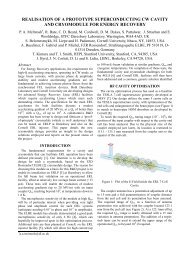
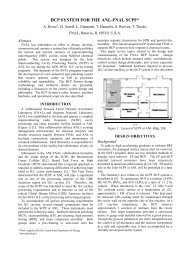
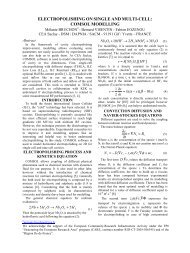

![å¨åæãæç©ä¿æ¤ææå¦ãï¼å¤§äºï¼ââå åºææååºç¨.ppt [å
¼å®¹æ¨¡å¼]](https://img.yumpu.com/42555314/1/190x135/aaaeaaeccaaeaeaea-ai-1-4-aai-1-4-aaa-aaeaeaacppt-a-1-4-araea-1-4-.jpg?quality=85)
